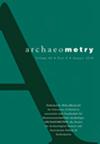The first isotopic evidence of Early Iron Age lead ore exploitation in the Silesian-Krakow upland, Poland: a provenance study of Lusatian culture lead ornaments
IF 1.5
3区 地球科学
0 ARCHAEOLOGY
引用次数: 0
Abstract
The Bronze and Early Iron Ages witnessed a significant increase in trade relations driven by the search for valuable metals. This paper presents new insights into the use of galena from the Silesia and Krakow Upland region in southern Poland, known as the ‘Olkusz ore deposits’, within the context of metal ores in prehistoric Europe. Eleven lead-based ornaments from Lusatian Urnfield Culture cemeteries were examined using lead isotope analysis. The majority of these ornaments were found to be made from local ore, which provides evidence for the early exploitation of Olkusz lead deposits dating back 1,000 years earlier than previously known from archaeological artefacts.

波兰西里西亚-克拉科夫高地早期铁器时代铅矿开采的首个同位素证据:卢萨特文化铅装饰品的出处研究
青铜时代和早期铁器时代,在寻找贵重金属的推动下,贸易关系显著增加。本文从史前欧洲金属矿石的角度,对波兰南部西里西亚和克拉科夫高地地区(被称为 "奥尔库什矿床")方铅矿的使用提出了新的见解。研究人员利用铅同位素分析方法对卢萨西亚乌恩菲尔德文化墓地中的 11 件铅制装饰品进行了研究。研究发现,这些装饰品大多由当地矿石制成,这为奥尔库什铅矿床的早期开采提供了证据,其时间比考古文物中已知的要早 1000 年。
本文章由计算机程序翻译,如有差异,请以英文原文为准。
求助全文
约1分钟内获得全文
求助全文
来源期刊

Archaeometry
地学-地球科学综合
CiteScore
3.60
自引率
12.50%
发文量
105
审稿时长
6 months
期刊介绍:
Archaeometry is an international research journal covering the application of the physical and biological sciences to archaeology, anthropology and art history. Topics covered include dating methods, artifact studies, mathematical methods, remote sensing techniques, conservation science, environmental reconstruction, biological anthropology and archaeological theory. Papers are expected to have a clear archaeological, anthropological or art historical context, be of the highest scientific standards, and to present data of international relevance.
The journal is published on behalf of the Research Laboratory for Archaeology and the History of Art, Oxford University, in association with Gesellschaft für Naturwissenschaftliche Archäologie, ARCHAEOMETRIE, the Society for Archaeological Sciences (SAS), and Associazione Italian di Archeometria.
 求助内容:
求助内容: 应助结果提醒方式:
应助结果提醒方式:


